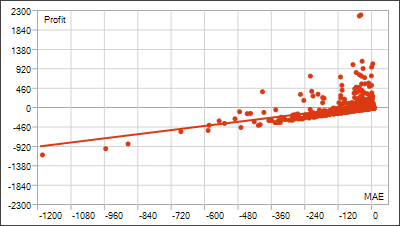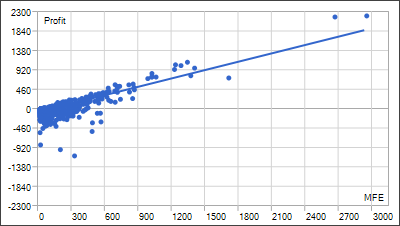- Errors, bugs, questions
- Questions from Beginners MQL5 MT5 MetaTrader 5
- How to calculate the max drawdown ? Is max drawdown in tester report is true ?
The absolute drawdown of each order is called the Maximum Adverse Excursion (MAE). It is shown in MT5 reports but it is not available on MT4.
The absolute drawdown of each order is called the Maximum Adverse Excursion (MAE). It is shown in MT5 reports but it is not available on MT4.
Really? Then I must have the wrong idea about what Absolute Drawdown is.
My understanding is: the largest difference between two prices within a period where one price is the lowest and the other is the highest within that same period.
For example: 5, 10, 15, 20, 15 (dropped 5), 20, 40, 30 (dropped 10), 35, 40, 50, 45 (dropped 5), 50, 60
Absolute Drawdown = 10
I wasn't really sure about what Absolute Drawdown was so I wrote my own code to calculate it.
After printing it all, I noticed that my own code written from scratch produces the exact same value that is printed in the Strategy Tester report, in the "drawdown $" column.
Every time.
Now, if Absolute Drawdown is something else, then maybe yazeedscan write his own code and add it to the report manually.
Absolute Drawdown is for the entire trade history, not for individual orders or positions.
The OP's question was, and I quote ... "Absolute Drawdown for each order?"
For each order, it is ... Maximum Adverse Excursion (MAE)
For the entire trade history, it is then ... Absolute Drawdown
Absolute Drawdown is for the entire trade history, not for individual orders or positions.
The OP's question was, and I quote ... "Absolute Drawdown for each order?"
For each order, it is ... Maximum Adverse Excursion (MAE)
For the entire trade history, it is then ... Absolute Drawdown
I see. Thank you for clarifying.
But then I suspect the original poster may be making a mistake.
The absolute drawdown of any individual order may be relatively harmless, but a few bad consecutive orders may kill the account.
Knowing your MAE and MFE is much more important than just knowing your Absolute drawdown. A strategy's MAE and MFE statistics is key to understanding its robustness and whether it can be improved or not.
MAE-Profits Distribution (MT5 report)
MFE-Profits Distribution (MT5 report)
Knowing your MAE and MFE is much more important than just knowing your Absolute drawdown. A strategy's MAE and MFE statistics is key to understanding its robustness and whether it can be improved or not.
MAE-Profits Distribution (MT5 report)
MFE-Profits Distribution (MT5 report)
Thank you for the advice, I appreciate it.
It's too bad it's going right over my head.
If you would like to tell me why knowing that information is so important rather than just setting a hard limit on the MAE of each order and gauging the end result, that would be great.
But I don't want to impose or anything.
In my logic, Absolute Drawdown is very important because a bad spell is harmless if it hits after the account has picked up some profit that will then serve as a safety net, but it will kill the account if it hits right in the beginning, so there must be a strict hard limit on Absolute Drawdown. Now, the Absolute Drawdown of a single order doesn't really make sense to me.
There is plenty of information on the web, videos and books, describing the Maximum Adverse Excursion (MAE), Maximum Favorable Excursion (MFE) and e-Ratio metrics.
In fact, if I remember correctly, there should be a website by a Brazilian trader completely dedicated to it, but unfortunately I don't remember the traders name or the website's URL.
There is plenty of information on the web, videos and books, describing the Maximum Adverse Excursion (MAE), Maximum Favorable Excursion (MFE) and e-Ratio metrics.
In fact, if I remember correctly, there should be a website by a Brazilian trader completely dedicated to it, but unfortunately I don't remember the traders name or the website's URL.
The absolute drawdown of each order is called the Maximum Adverse Excursion (MAE). It is shown in MT5 reports but it is not available on MT4.
Yes, the MAE for each order is what I'm looking for. I just did a 1 month backtest for my EA in MT5 and the report doesn't show the MAE for each order. In the summary, it shows the Balance Drawdown and Equity Drawdown but that's for the whole duration of the backtest (1 month) and I'm assuming this is the max drawdown of the entire backtest. Is there a way in MT5 or any other tool to show the MAE/max drawdown for each order instead of a summary for the whole backtest duration?
What you want can be calculated. You can add the functionality to the EA you are already using.
It's not hard either. You keep monitoring your position and how much it's making or losing. The initial value is the highest value. Whenever the profit exceeds the highest value, the new high profit becomes the highest value. Conversely, whenever the profit goes down, it marks a "floor" i.e. the lowest point in the order's profit trajectory. Every time you get a new "floor," you measure the difference between that floor and the highest profit within the order's trajectory. That will be your MAE.
- Free trading apps
- Over 8,000 signals for copying
- Economic news for exploring financial markets
You agree to website policy and terms of use

